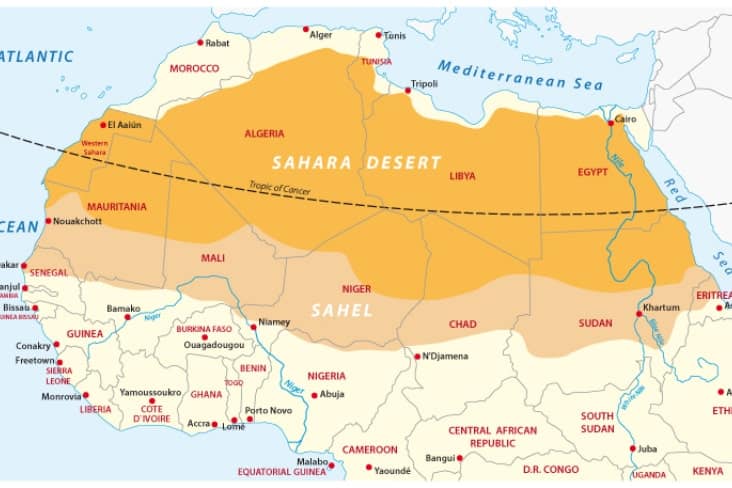The most interesting facts about Libya, from an ancient crossroads of civilisations to bizarre natural phenomena in the Sahara Desert.

Fast facts
Official name: State of Libya
Capital city: Tripoli
Population: 6,890,535
Area: 1,759,540 sq km
Major languages: Arabic, Italian, English, Berber
Time zone: UTC+2 (Eastern European Time)
– Source: CIA World Fact Book
Interesting facts about Libya
1. Libya, located in North Africa, is the continent’s fourth-largest and the world’s 16th largest country by area.
– Source: World Bank
2. Libya has been inhabited for thousands of years. The UNESCO-listed Rock-Art Sites of Tadrart Acacus has a collection of thousands of cave paintings dating from 12,000 BC to 100 AD.
– Source: UNESCO
3. Libya was originally inhabited by the Berber people, also known as Amazigh. Berbers are considered the indigenous inhabitants of North Africa and have occupied the region since at least 2000 BC.
– Source: The Atlantic, Britannica
4. Libya has an ancient history: in the 7th century BC, Phoenicians settled in Tripolitania; in the 6th century BC, Carthage conquered Tripolitania; in the 4th century BC, Greeks colonised Cyrenaica and named it Libya; and in 74 BC, the Romans conquered Libya.
– Source: BBC News
5. The UNESCO-listed Archaeological Site of Cyrene was one of the main cities of the Greek empire. It was founded around 631 BC and was later incorporated into the Roman Empire until an earthquake struck in 365 AD.
– Source: Britannica, UNESCO

6. Libya was also part of the Ottoman Empire from the 16th century until Italy seized control around 1911-12.
– Source: BBC News
7. The name Libya stems from an ancient tribe called the Libu, first mentioned in texts from the 13th century BC.
– Source: CIA World Fact Book
8. During World War II, Italy was ousted by the Allied forces. France and Britain administered the country until 1951 when Libya became independent under King Idris I.
– Source: Britannica
9. Libya has Africa’s largest and the world’s ninth-largest proven oil reserves, with 48 billion barrels in 2019.
– Source: US Energy Information Administration (EIA)
10. Following independence, Libya was divided into three regions – Tripolitania, Cyrenaica and Fezza – which are represented in Libya’s flag of three horizontal stripes of red, black and green. The flag also features a star and crescent which are symbolic of Islam, as is green.
– Source: Britannica, Britannica

11. King Idris I was deposed by Colonel Gaddafi in 1969 who ruled until he was killed in 2011.
– Source: BBC News
12. Gaddafi was toppled in 2011 following an armed rebellion assisted by Western military intervention. The rebellion led to a civil war which then led to Gaddafi’s death following his capture by rebel forces.
– Source: CNN
13. From 1977 to 2011, Libya was renamed the Libyan Arab Republic to the Great Socialist People’s Libyan Arab Jamahiriyah by Gaddafi.
– Source: BBC News
14. During that time, the country had a plain green flag which was the only national flag to have a single plain colour. After Gaddafi’s overthrow, the flag reverted and the red also came to represent the blood that was shed for freedom.
– Source: DK (2014) Complete Flags of the World: The Ultimate Pocket Guide. DK: London

15. Tripoli, Libya’s capital, was originally founded by the Phoenicians in the 7th century BC. The city changed rulers many times and by the 3rd century AD it was known as Regio Tripolitana by the Romans, meaning “region of the three cities” which derives from the Greek words “tria” and “polis” meaning “three cities”
– Source: CIA World Fact Book
16. One of these cities was the UNESCO-listed Leptis Magna, widely accepted as one of the most beautiful cities of the Roman Empire.
– Source: UNESCO
17. Libya is Africa’s most obese nation and the world’s 18th most obese. 66.8% of adults are overweight.
– Source: World Health Organisation
18. Over 90% of Libya is desert or semidesert.
– Source: CIA World Fact Book

19. Libya is part-home to the Sahara Desert, the world’s largest hot desert (excludes Arctic and Antarctic deserts). The part of the Sahara in Libya is known as the Libyan Desert.
– Source: National Geographic, Britannica
20. Hidden in the Sahara is the Ubari Sand Sea, a deep red lake fed by springs from an underground aquifer created by ancient rains. The lake gets its colour from algae adapted to survive in its hypersaline water.
– Source: National Geographic
21. Deep in the Libyan Sahara Desert is the Waw an Namus volcanic crater. The crater is the remnants of an ancient volcano that carried black ash 12 miles across the set and is in stark contrast to the surrounding sand.
– Source: National Geographic, NASA

22. According to the UK Foreign Office, Libya is one of 17 countries deemed to be entirely unsafe for tourists to visit.
– Source: The Telegraph
23. Libya is also among the 10 most dangerous countries in the world according to the International SOS Travel Risk Map. It has been assessed as carrying an ‘extreme travel security risk’.
– Source: The Independent
24. Libya has Africa’s second-highest CO2 emissions after South Africa when measured by metric tons per capita. It has the world’s 26th highest.
– Source: World Bank
25. Libyan Abdelbaset al-Megrahi was convicted of the worst terrorist attack in UK history. In 1988, 270 people died when Pan Am Flight 103 exploded over the Scottish town of Lockerbie. In 2001, Megrahi was found guilty of murder after a historic trial under Scottish law in the Netherlands.
– Source: BBC News
Every effort has been made to verify these facts about Libya. However, if you find an error or have any questions, please contact us.